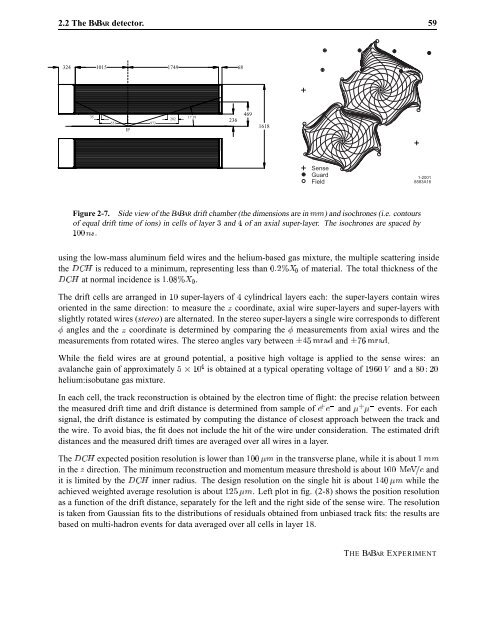Violation in Mixing
Violation in Mixing
Violation in Mixing
Create successful ePaper yourself
Turn your PDF publications into a flip-book with our unique Google optimized e-Paper software.
2.2 The BABAR detector. 59<br />
324 1015 1749<br />
68<br />
35<br />
551 973<br />
IP<br />
202<br />
17.19<br />
236<br />
469<br />
1618<br />
Sense<br />
Guard 1-2001<br />
8583A16<br />
Figure 2-7. Side view of the BABAR drift chamber (the dimensions are <strong>in</strong> ÑÑ) and isochrones (i.e. contours<br />
of equal drift time of ions) <strong>in</strong> cells of layer and � of an axial super-layer. The isochrones are spaced by<br />
Ò×.<br />
us<strong>in</strong>g the low-mass alum<strong>in</strong>um field wires and the helium-based gas mixture, the multiple scatter<strong>in</strong>g <strong>in</strong>side<br />
the ��À is reduced to a m<strong>in</strong>imum, represent<strong>in</strong>g less than � � of material. The total thickness of the<br />
��À at normal <strong>in</strong>cidence is � � � .<br />
The drift cells are arranged <strong>in</strong> super-layers of � cyl<strong>in</strong>drical layers each: the super-layers conta<strong>in</strong> wires<br />
oriented <strong>in</strong> the same direction: to measure the Þ coord<strong>in</strong>ate, axial wire super-layers and super-layers with<br />
slightly rotated wires (stereo) are alternated. In the stereo super-layers a s<strong>in</strong>gle wire corresponds to different<br />
� angles and the Þ coord<strong>in</strong>ate is determ<strong>in</strong>ed by compar<strong>in</strong>g the � measurements from axial wires and the<br />
measurements from rotated wires. The stereo angles vary between ¦�� ÑÖ�� and ¦�� ÑÖ��.<br />
While the field wires are at ground potential, a positive high voltage is applied to the sense wires: an<br />
avalanche ga<strong>in</strong> of approximately � ¢ � is obta<strong>in</strong>ed at a typical operat<strong>in</strong>g voltage of �� Î and a � �<br />
helium:isobutane gas mixture.<br />
In each cell, the track reconstruction is obta<strong>in</strong>ed by the electron time of flight: the precise relation between<br />
the measured drift time and drift distance is determ<strong>in</strong>ed from sample of � � and � � events. For each<br />
signal, the drift distance is estimated by comput<strong>in</strong>g the distance of closest approach between the track and<br />
the wire. To avoid bias, the fit does not <strong>in</strong>clude the hit of the wire under consideration. The estimated drift<br />
distances and the measured drift times are averaged over all wires <strong>in</strong> a layer.<br />
The ��À expected position resolution is lower than �Ñ <strong>in</strong> the transverse plane, while it is about ÑÑ<br />
<strong>in</strong> the Þ direction. The m<strong>in</strong>imum reconstruction and momentum measure threshold is about Å�Î� and<br />
it is limited by the ��À <strong>in</strong>ner radius. The design resolution on the s<strong>in</strong>gle hit is about � �Ñ while the<br />
achieved weighted average resolution is about � �Ñ. Left plot <strong>in</strong> fig. (2-8) shows the position resolution<br />
as a function of the drift distance, separately for the left and the right side of the sense wire. The resolution<br />
is taken from Gaussian fits to the distributions of residuals obta<strong>in</strong>ed from unbiased track fits: the results are<br />
based on multi-hadron events for data averaged over all cells <strong>in</strong> layer �.<br />
Field<br />
THE BABAR EXPERIMENT















